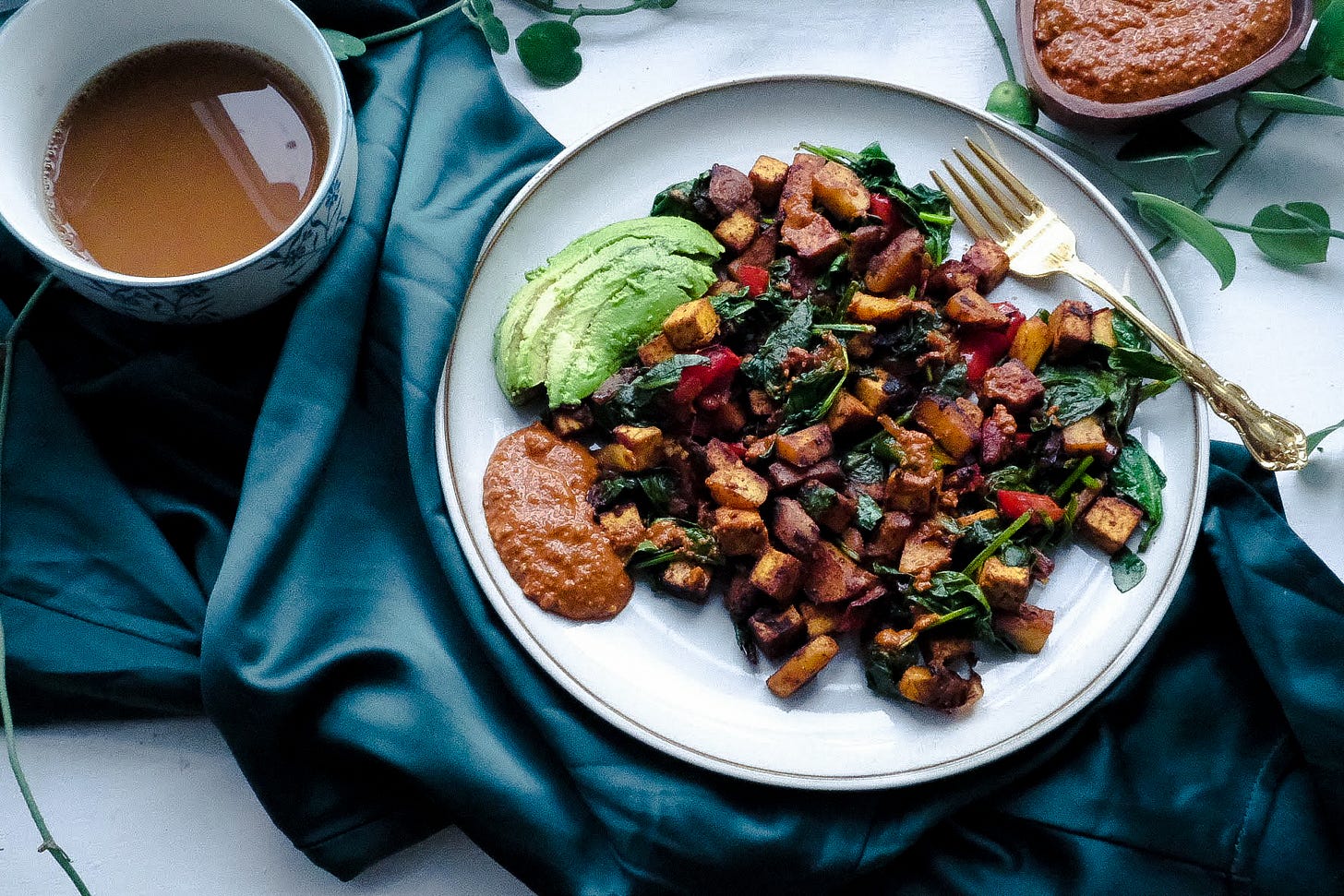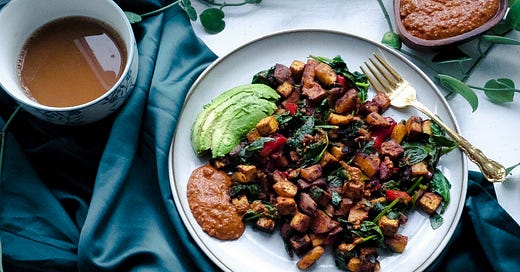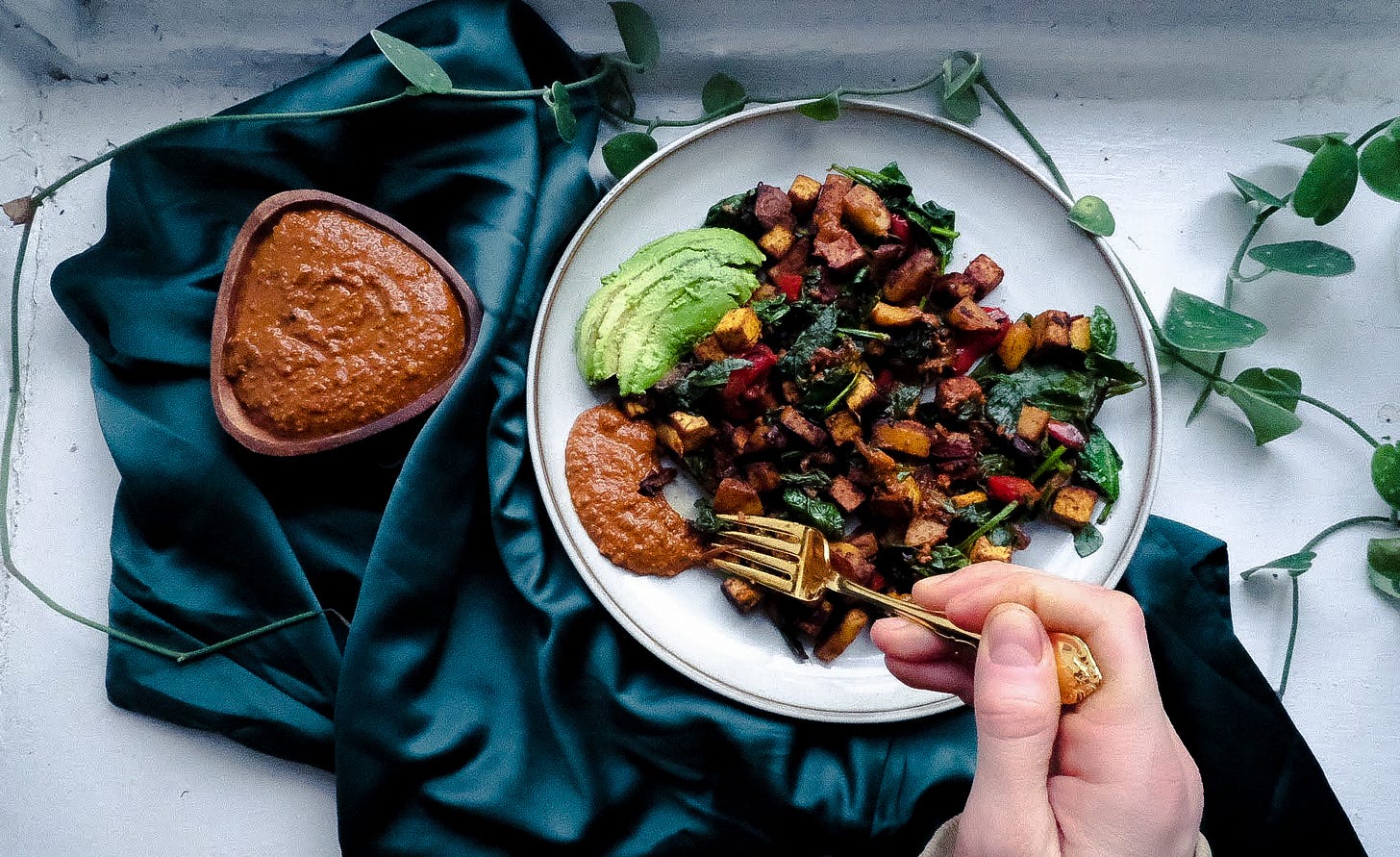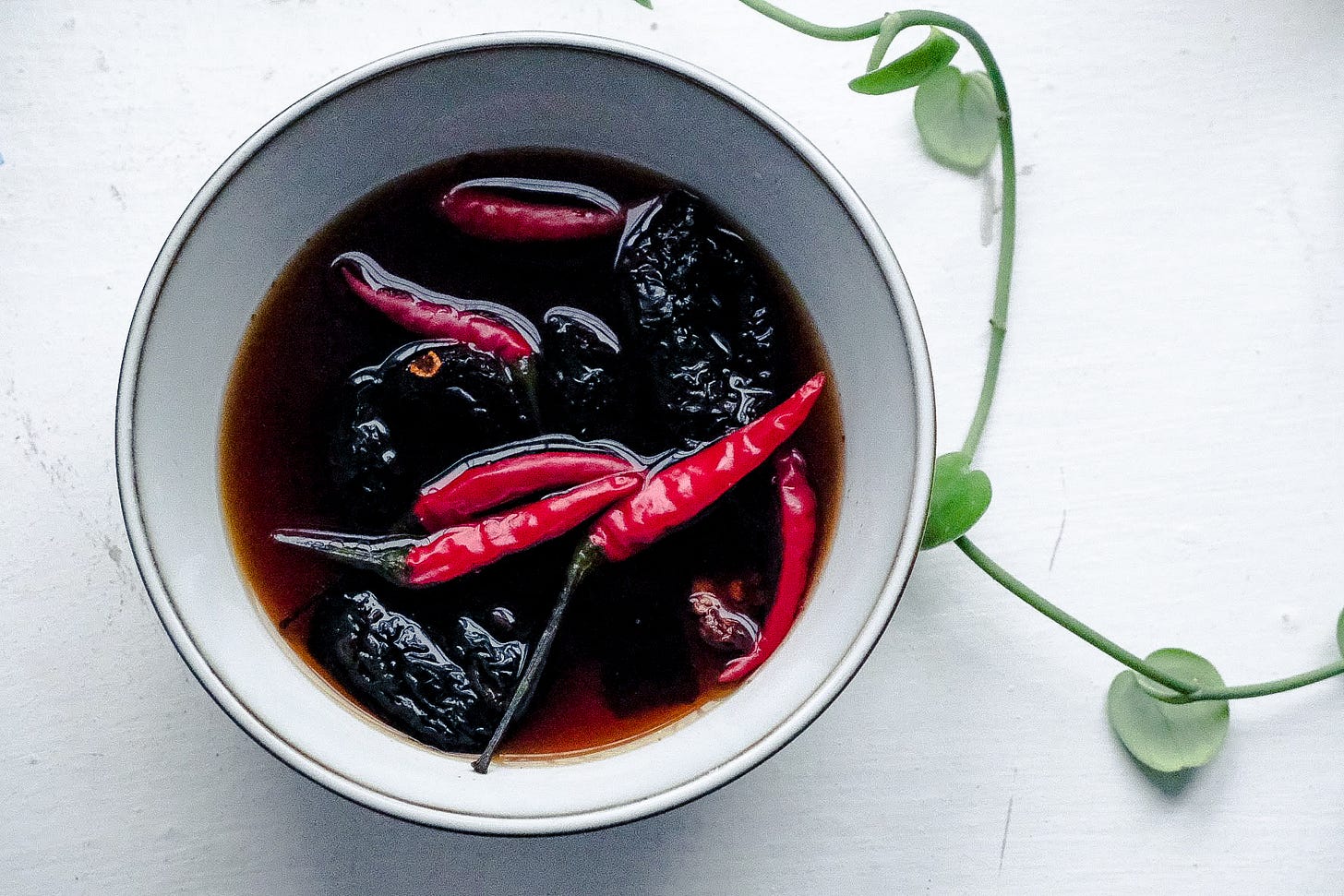Sharing Intimacy Through Food with Line Cook Sarah Goldstone - No. 12
And rethinking what we consider "breakfast foods."
Welcome to Vegarie. If you found your way to my substack looking for Sarah Goldstone’s cooking in the bathtub videos, you’re out of luck…she’d never release those to the public. Maybe the one-millionth subscriber will get lucky, and I’ll send over a copy. Who knows, it could be you! Tap below to subscribe (for free!) and receive my biweekly newsletter on Tuesdays. Included are interesting stories about women who cook and their tips on becoming more creative in the kitchen. Additionally, I share recipes for dips, spreads, and condiments that are sure to spice up anything you’re making at home.
In this week's newsletter, my featured guest is the amazing Sarah Goldstone. A native New Yorker, line cook, biography and memoir writer, and matzo ball soup extraordinaire. Yes, she’s Jewish. So, although I haven’t tried her soup, I believe it’s better than everyone else’s. Together, we talk about her first experiences as a line cook, the sensuality of cooking, and the crazy (and delicious) breakfasts she’s known for creating before her shifts at Cervo’s.
On top of that, our chat inspired me to make one of Sarah’s favorite dips; salsa macha, and I’ve shared the recipe below. For those that haven’t tried it before, salsa macha originates from Veracruz, Mexico, and is generally comparable to more of a chili crunch than a smooth or fresh salsa. It includes toasted chiles, peanuts, and lots of tears…yeah, I accidentally made my batch too spicy. But don’t worry, I’ve adjusted my recipe, so you won’t make the same mistake. I also chose to increase the number of peanuts in my recipe to make it a little fuller-bodied like a dip. Whether you’re a woman interested in cooking professionally, want to learn a bit more about what that’s like first-hand, or just love a salsa macha, I think everyone will have something to take away from this week’s post.
Ok! First things first, Sarah and I met just a few months ago working the line together at Cervo’s, a vibey seafood restaurant on the Lower East Side of Manhattan. Being the only two women in the kitchen, Sarah and I bonded immediately. Unlike myself, who is a total newbie in a professional kitchen, Sarah has been cooking for years. We get into this a bit more later, but it was such a comfort when she joined because not only were we able to understand each other, simply by being women in this role but with more experience, she made me feel like I could ask her all the stupid questions I’d been holding back on with the others.
Sarah grew up in Queens and recalls, “eating take-out Chinese, like every day,” because her parents weren’t big on cooking. Another common meal from her childhood with sushi, fake sushi that is, prepared with her sisters in the bathtub by rolling up a washcloth. You’ve got to send me that recipe, Sarah, I’ve been thinking about making washcloth sushi for months.
“I remember rolling the washcloths as sushi and facing a pretend audience. It was a cooking show bit that we’d do, no real recording. When we cooked together for real in the kitchen later in life, we didn’t make a show of it.”
Close to both of her sisters, Sarah would also cook a lot with them, simple things like eggs, pasta, or vegetables. However, she did practice for her future as a sous-chef by leaving her oldest sister notes with instructions on how to properly make her turkey sandwiches for her lunch on school nights.
While working on her undergraduate degree in creative writing at Oberlin College, Sarah worked in one of their Co-op kitchens. It was there that she found her love for cooking. Post-graduation, she moved to France for a year and worked as an Au Pair. Cooking for the family was, of course, her favorite part. They gave her full freedom to choose groceries and prepare meals, a fun experience in French cooking. After returning to New York City, Sarah received her first opportunity to work on a line—at LEO, a laid-back bistro with phenomenal sourdough bagels, pizza, and silky butter beans that will blow your mind.
“Pizza is still line cooking, but a really specific kind of line cooking. At LEO it was three people, and you were either topping pizzas, opening* pizzas, or baking pizzas. Then there was the position where you could finish pizzas and expedite, which is not really cooking, but it is what I pretty quickly ended up falling into.”
* “Opening,” a pizza is the process of shaping and spreading the dough before being topped. Sarah says this process is very delicate and easy to fuck up.
As an expediter at LEO, Sarah mostly helped out with prep before service, finished pizzas, and grew to understand the process of line management at a higher level. “The staff and main chef at LEO created a positive working environment for everyone. The chef loved candy, so he would always bring in candy and share it. He’d make jokes, make up words—he wouldn’t yell—he was calm and guided you.”
Being the only woman in the kitchen there, she felt like she “could bro-out, I’m sure even more than any of the men. Talk about sports, women that come into the restaurant, that kind of thing to bond. But I am much more sensitive or in my head, and wanted to find an environment where I could work with more women.” After leaving LEO, Sarah worked for a couple of months as a pastry chef at a spot in Bushwick. There, she learned a lot in a short time but quickly discovered that their working environment was extremely toxic and needed to find a way out. Sarah reached out to friends and eventually found her gig at Cervo’s, where we both work now.
“…To check the temperature up against your skin, to serve it to someone else…it creates this kind of intimacy that is so special. A kind, I think, that can only be communicated to others through food.”
Not only does Sarah work the exhausting four 11-hour shifts a week at Cervo’s, but she is also completing her Master’s in biography and memoir writing on the side. When asked, she said she’s not sure how she plans to connect the two, but “I think in my deep brain, there’s a connection between what I write about and cooking. I write about daughterhood and what that can mean, not always in relation to parents. I’m kind of estranged from my parents, although I used to be very close to my mom. I’m evaluating how the past and present can both be true, and what that means for my identity.” For her, it seems that daughterhood and cooking overlap in terms of nourishment or care. “Maybe I cook to take care of others or eat to feel taken care of.”
Drawing further parallels between intimacy and food—her professor has been talking about sensuality in their writing, making her more aware of the sensuality of cooking…even at Cervo’s.
“Like, not in an oooh dirty, sex way, but—the cake tester, for example, how we insert it into the lamb on the grill and hold it above our lip to test the temperature—It’s such an intimate gesture. To check the temperature up against your skin, to serve it to someone else…it creates this kind of intimacy that is so special. A kind, I think, that can only be communicated to others through food.”
Growing up, Sarah was also a competitive gymnast and had insecurities around food that were indulged through her relationship with her mother. As women, I think this is something we all go through at some point with disordered eating already fed to us in so many forms of media. However, her mom would say things like “oh, you don’t need carbs with that. Which is insane to be told by a parent at any age, but you’re especially impressionable as a kid.” Now, she sort of carries her love of food as a personality trait. It appears in her writing, it appears in the intimate way she makes dishes for others, and she hopes to share, by example, with other women that you can have a lifestyle where you eat what you want.
“That’s something I also love about our chef, Aaron. His mentality on just eating as you go, not limiting yourself, always taking little bites, and this idea of indulgence baked into what we do, but in a good way.”
This morning before meeting me, she had pork buns and watercress tossed in sesame oil, garlic, and soy sauce. We could all find some pleasure in learning to break the traditional idea of “breakfast foods,” for breakfast. “For me, my crazy breakfasts, and cooking in general, are a part of being able to really love food again and to encourage other people to as well.”
“I eat a lot of frozen dumplings—I don’t really eat breakfast foods.”
So, what are Sarah’s favorite crazy breakfasts? “I’d say my top right now for breakfast before work is dumpling noodle soup. Or frozen maybe dumplings. Most recently I made a version of Hetty McKinnon's tomato egg drop soup with noodles, and some pork chive and cabbage dumplings from Chinatown. Garnished with scallions, sesame oil, soy sauce, and chili crisp. It was perfect.”

Rapid-fire tips from Sarah
If you could give younger you some tips, regarding your current career path, what would you tell her?
“I think my first tip would be to pursue cooking right away after college! I tried to, by getting a job at this creperie restaurant where I knew the owner, but he put me as a barista, and I didn't really fight to work in the kitchen. I'd also have some advice for the younger me and current me—which is not to get in your head. As in, cooking is hard. Everyone fucks up. Maybe in small ways, but it happens all of the time. To be successful I think it’s mad important not to get attached to one mistake, to just move on and get back in the vibe. I aspire to be like this but I’m definitely still learning.”
What would you tell someone that’s considering a career in the kitchen or maybe transitioning from another role but is afraid to leap?
“Nerves about switching from any career to another are normal. I don’t know how any one person will feel, but I will say that cooking is the first job I’ve worked where I don’t experience the Sunday-scaries. So, even if starting fresh is a lot at first, I think cooking is worth it because, for the most part, you can leave the work at work—though sometimes I do have stress dreams of disappointing Tyler (our sous-chef at Cervo’s). My other tip would be to be patient with yourself. Even if you cook well at home, those skills don’t always translate right away to line cooking. It takes time to get good in a new setting, at a new scale, and new pace, just like any other new thing you try. I’m constantly reminding myself that.”
What is your favorite dip?
“In my opinion, the more accouterments for a meal the better so it’s hard to just pick one. Is dijon a dip? If not, my favorite dip is baba ghanoush, made with tahini, not mayo. I also like to keep romesco sauce in the fridge as well, it’s nice with potatoes or with some cheese and crackers if you feel like being fancy. I love chili crisp—specifically the glass jar with red label and green sticker, I think it’s Lao Gan Ma—and also, salsa macha. I like when food is an activity.”
What is your go-to for dinner parties?
“My go-to is a whole roasted chicken, like with shallots, garlic, and lemon, roasted in the oven. Sometimes I’ll make a romesco sauce on the side. I love a good Caesar salad or green beans, and then an olive oil cake.”
If you opened a restaurant one day, what would you serve?
“I’m not sure if I will. But if I did, it would be a small menu that changes frequently. Shareable dishes so that people can try more rather than order one big entree. Simple, seasonal ingredients, and a lot of condiments.”
Why is food so important to you and why do you feel like it brings so many people together?
“There is a sort of intimacy and care you can only show someone through food or for cooking for them. I was just telling my partner this the other day, but one of the joys of my life is being in a restaurant environment. Cooking dope food and being surrounded by people who are enjoying it. There’s no place with a better feeling for me. Whether I’m dining myself or working the line, it just makes me so happy to see everyone contribute to the experience.”
Salsa Macha
Originating in Veracruz, Mexico, salsa macha is comparable to more of a chili crunch than a smooth or fresh salsa. Including toasted chiles, peanuts, and three different peppers, this spicy sauce is typically drizzled over things rather than dipped into them. Looking for something a little fuller bodied and dip adjacent, I increased the number of peanuts and blended further than is traditional in my recipe.
Ingredients
6 Tbs sunflower oil (or avocado, or vegetable!)
6 dried ancho chiles, stems removed, seeds removed
6 dried arbol chiles, stems removed, seeds removed
2 dried guajillo chiles, stems removed, seeds removed
5 cloves garlic
1/2 cup apple cider vinegar
1 1/4 cup water
1 Tbs brown sugar
2/3 cup peanuts, roasted and salted
Salt to taste (I used three big, 3-finger pinches but start small and taste!)
Instructions
Bring a heavy cast iron pan to medium heat, warm your oil of choice in the pan.
Add in all of your chiles** and toast until lightly browned. Remove with a slotted spoon from the oil and place in a bowl for later.
**Make sure you have removed the stems and the seeds, especially if you’re sensitive to heat! I didn’t remove any of my seeds when I made this batch and I dissolved into a sweaty mess.
Add in your garlic to the same oil and fry until lightly golden. Remove with slotted spoon and place in the same bowl with your chiles.
Combine your water, sugar, and vinegar in a small bowl and pour into the hot oil. Be careful as this will sizzle loudly and burn off. You’re cooling down your oil here to add to the food processor.
Add all ingredients, solids and liquids to a food processor. Note that this is a lot of liquid and depending on the size of your processor, you may want to begin with just half the liquid until the larger pieces are broken down and then slowly add the remaining liquid.
Blend together until semi-smooth. There should still be small chunks of peanut—think like a muhammara sauce or pesto where all ingredients are combined but the nuts still add a nice texture.
Salt to taste. I recommend that you store this sauce in the fridge. You can use it as a dip with tortilla chips, or drizzle over anything you’d like! With the additional peanuts here, I’ve found that this dip pairs well with Hispanic, Asian, and Mediterranean spice profiles. I’ve been enjoying mine with rice and veggies, on the side of a cumin and paprika spiced tofu scramble (pictured all throughout the blog) or even on the side of leftover Pad Kee Mao noodles.







